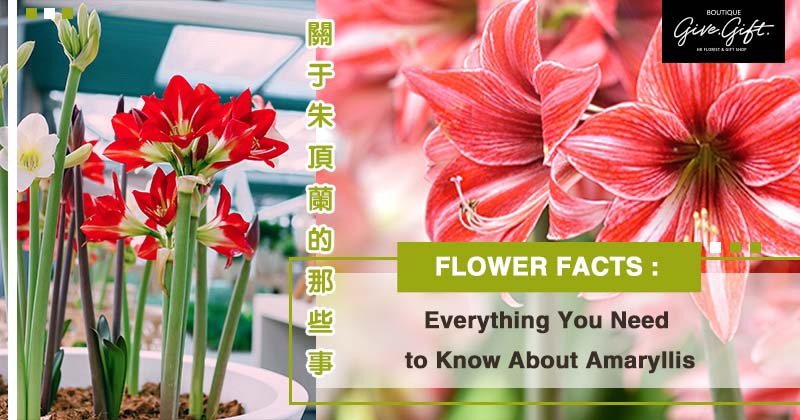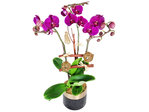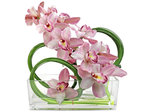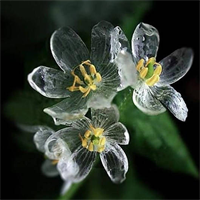What slender campanili grew
By bays, the peacock’s neck in hue;
Where, here and there, on sandy beaches
A milky-bell’d amaryllis blew.
- “The Daisy” by Alfred Tennyson
Amaryllis, a trumpet-shaped beauty of a flower is also commonly known as the belladonna lily or the Jersey lily. Amaryllis comes from the Greek word amarysso, which means "to sparkle”, a very fitting and suitable name for this stunning flower. Its name is also derived from a character in Virgil's pastoral Eclogues. Popular by florists and gardeners alike for its sturdiness and long cut flower life, the amaryllis has been captivating flower connoisseurs for hundreds of years.
Scientific Information
Amaryllis is the only genus in the subtribe Amaryllidinae. It’s a very small genus consisting of only two bulb flowering species, the Amaryllis belladonna and Amaryllis paradisicola. Its taxonomy has been slightly controversial as these two species were placed into Amaryllis genus in the 1700s but by the early 19th century the Amaryllis genus had become so hugely diverse, so attempts were made to separate them. The genus of Hippeastrum was then created in which a large portion of species were moved to this genus, with the debate remaining today about the placement of species between these two genera. While the Hippeastrum and Amaryllis have similar shapes, the Hippeastrum species have hollow stems. Today, most amaryllis are hybrids but are still classified in the genus Hippeastrum.
Amaryllis is a bulbous plant that produces a cluster of two to twelve funnel-shaped flowers. The flowers themselves can grow between 6-10cm in diameter and are perennials plants. While many amaryllises will continue to grow every spring for a few years some have been known to bloom for up to 75 years.
Origins
Amaryllis belladonna grows natively in the Western Cape region of South Africa while the Amaryllis paradisicola grow in the Northern Cape region of South Africa as they prefer a much drier and cooler environment than the Amaryllis belladonna. Both species have since naturalised in countries all over the world.
History of Amaryllis
While brought to Europe in the 1700s, the Amaryllis belladonna, the most widely cultivated type of amaryllis, was first cultivated at the beginning of the eighteenth century in Australia. In its cultivation it was crossed with a species, that even to this day, is not known, which created the colour variations of white, peach, pink, red, and cream.
Amaryllis Colours
Amaryllis comes in a wide range of colours thanks to its extensive history of crossbreeding. The flowers can come in solid shades, bicoloured or picotee.
Common Amaryllis Colours:
• Red
• Yellow
• Green
• White
• Pink
• Orange
• Purple
• Salmon
• Burgundy
Common Amaryllis Types
There are more than 500 different varieties of Amaryllis flowers. Here are some of the more popular types.
Apple Blossom
This aptly named flower has white petals, feathered in soft pink and highlighted with a lime green throat giving it the appearance of a pink apple. Each bulb can produce up to three stems and can grow up to 2 ft long. This award-winning flower is very popular with gardeners.
Hercules
The blooms of a Hercules amaryllis are large and come in deep red/pink shade with white shading near the tips. The Hercules bloom is known for its long last blooms and its romantic hues making it a great selection for a romantic arrangement of flowers.
Magic Green
Magic green amaryllis are stunning flowers that come in ivory to pale green shade with touches of burgundy. This is a dwarf type of amaryllis, so the petals of the magic green are a bit smaller but its appearance means it easily stands out.
Dancing Queen
This type of amaryllis bears resemblance to a peony due to its large double petals and its red and white striped colour. Its shape and colours are striking making this an easy centrepiece for a flower arrangement.
Desire
This type of amaryllis comes in a stunning solid shade of orange or orange-red and makes wonderful additions to flower arrangements. Their pleasant sunny hue makes them perfect everyday flowers to adorn the home or office that’s guaranteed to lift your mood.
Amaryllis Symbolism
Amaryllis generally represents determination, beauty, success, and love. They’re often given in romantic flower arrangements or congratulatory flower arrangement. For the Victorians, it was associated with strength and determination, mostly due to their tall stalks and sturdiness.
The amaryllis is also the symbol for Huntington’s disease as it represents hope and determination for the hurdles and achievements that have been made in Huntington’s disease treatment and research.
Amaryllis Flower Arrangements
As amaryllis are such beautiful and unique flowers that come in so many different colours, they’re extremely suitable as cut flowers and in flowers arrangements. Its sturdiness and long last bloom also make them a favourite.
• White amaryllis pair well with other white flowers for a wedding flower arrangement or centrepiece.
• Red, pink, striped or picotee amaryllis are stunning in romantic flower arrangements and are especially relevant due to their symbolism in love and beauty.
• Red amaryllis looks beautiful in Christmas centrepieces or wreaths.
• Amaryllis pairs well with another spring bulb flower, the tulip, due to each of them having stalky stems.
• Orchids and amaryllis complement each other nicely due to their dynamic shape and colours.
• As amaryllis is also associated with determination, they make fantastic congratulatory flowers for things like a graduation, a new job, or a new home etc.
Amaryllis Care
Amaryllis are known as being extremely hearty, both in the garden, home, and as cut flowers. Amaryllis bloom in the spring and will grown again the following spring if the garden is well taken care of.
Garden/Potted Plant Care
Amaryllis require well-drained soil. The bulbs should be planted in late September or early October and should also be placed about a foot apart with the bulbs showing one-third to one-half about the growing surface. Mulch is advised to keep the moisture levels appropriate and to control weeds. Amaryllis also prefer partial sunlight or full shade when outdoors. Indoor plants need indirect sunlight.
After planting thoroughly water the bulbs. The bulbs should flower in 7-10 weeks (if indoors) or once spring arrives. Be sure to remove the spend blooms of the amaryllis to prevent seed formation by cutting the stem just above the bulb.
Cut Amaryllis Care
As many cut amaryllis are of the Hippeastrum genus they will have hollow stems. Due to this, it's not uncommon to see that some of the stems might have split or that they might start to curl in water. Wrapping to stems in a clear cello tape at its bottom can help to prevent this. The stem should be cut before being placed into water and again with every water change. Keep amaryllis out of direct sunlight and preferably in a dry environment. Bloom rates vary for amaryllis so be sure trim off the dying flowers so that the others can thrive.
General Flower Care:
• Cut the stems at a 45-degree angle.
• Use flower food.
• Prune and remove any dead or dying leaves or petals, especially if they’ve fallen in the water.
• Change the water daily.
• Keep flowers away from drafts, fans, and appliances that give off heat.
Related: How to Make Your Flowers Last Longe
More Facts About Amaryllis
• Amaryllis are tropical plants.
• Amaryllis can produce either single or double blooms.
• Amaryllis produce more stems and flowers if they have the larger bulbs.
• Some types of amaryllis are high in isoquinoline alkaloids. These are used in human medicines and are beneficial in treating, depressions, seizures, anxiety and even Alzheimer.
• Amaryllis is sometimes called a “naked lady” because the flowers grow before the leaves giving off a naked appearance.
Sources:
https://en.wikipedia.org/wiki/Amaryllis
This is a Hong Kong GGB original 'Flower Facts: Everything You Need to Know About Amaryllis ' blogpost.

























 Share
Share Tweet
Tweet +1
+1  Pin it
Pin it Post
Post  Weibo
Weibo Review
Review


















 Diwali Gifts
Diwali Gifts 
 ▶
▶